Renault MASTER 2005 Owner Manual
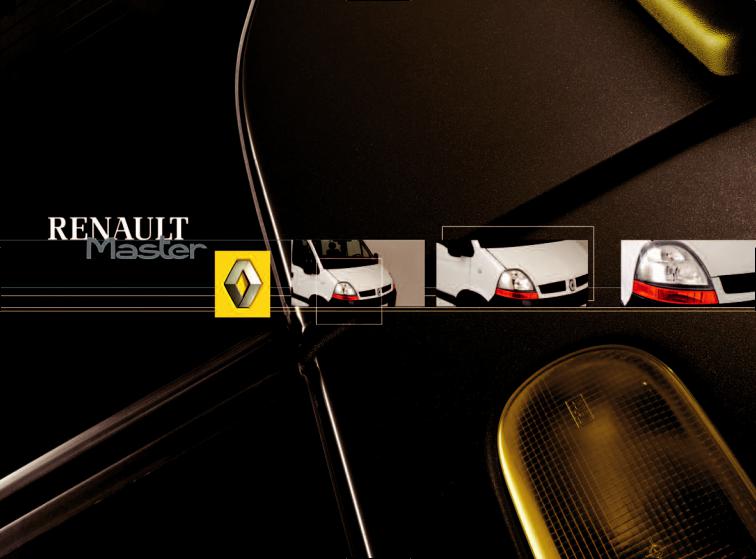
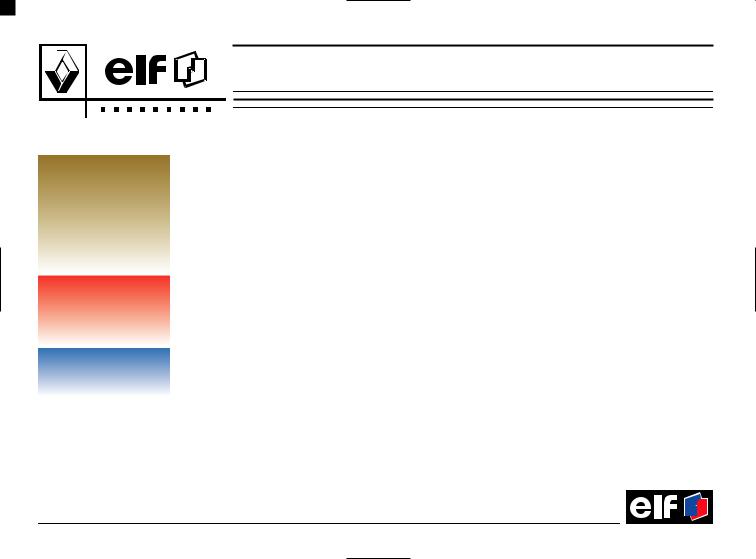



 recommends ELF
recommends ELF
For all |
ELF EXCELLIUM LDX 5W-40 |
ACEA A3 / B3 / B4 |
engines |
ELF ULTIMATE 5W-40 |
|
|
Premium performance. Best engine care under the most severe conditions |
|
|
ELF EVOLUTION SXR 5W-40 |
ACEA A3 / B3 / B4 |
|
Premium performance |
|
For all |
|
|
ELF COMPETITION ST 10W-40 |
ACEA A3 / B3 |
|
engines |
ELF PREMIER PLUS 10W-40 |
ACEA B3 / B3 |
|
ELF TURBO DIESEL 10W-40 |
ACEA B3 / B4 |
|
Other types of lubrifiants approved by RENAULT, for petrol or diesel engines. |
|
5 or 6-speed |
|
|
TRANSELF TRX 75W-80 |
API GL5 |
|
manual gearbox |
|
|
RENAULT recommends ELF approved lubricants.
For top-ups or oil drain, we recommand you to use only original lubricants.
For further information, please contact your RENAULT Dealer or go to www.lubricants.elf.com
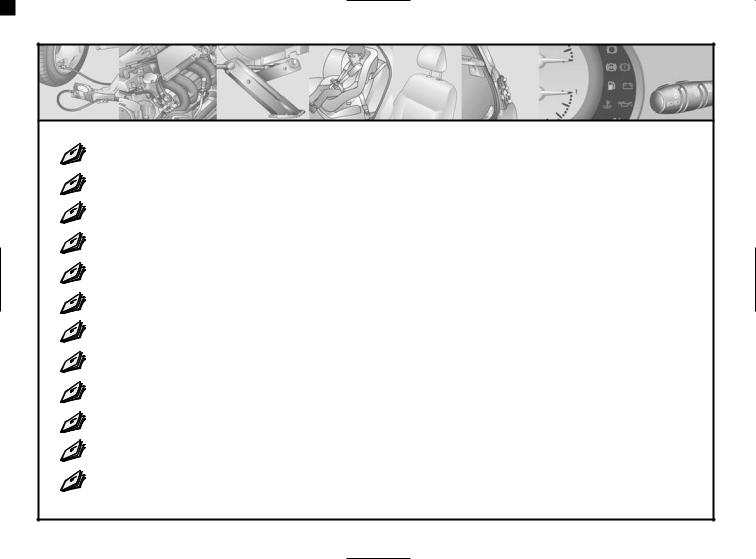
Brief overview
• Tyre pressures ....................................................................................................... |
|
0.04 |
• Adjusting the seats and the driver's position ........................................ |
1.16 - 1.17 |
|
• Child restraints ........................................................................................ |
1.27 |
1.35 |
• Warning and indicator lights ................................................................. |
1.40 1.47 |
|
• Horns and headlights ............................................................................... |
1.54 1.57 |
|
• Running in, driving ................................................................................ |
2.02 2.24 |
|
• Heating/Air conditioning ........................................................................ |
3.02 3.11 |
|
• Opening the bonnet ............................................................................................. |
|
4.02 |
• Levels (engine oil, windscreen washer, etc.) ....................................... |
4.03 |
4.09 |
• Emergency spare wheel .......................................................................... |
5.02 5.06 |
|
• Practical advice (replacing the bulbs, fuses, repairs, |
|
5.37 |
operating faults) ................................................................................... |
5.02 |
|
0.02
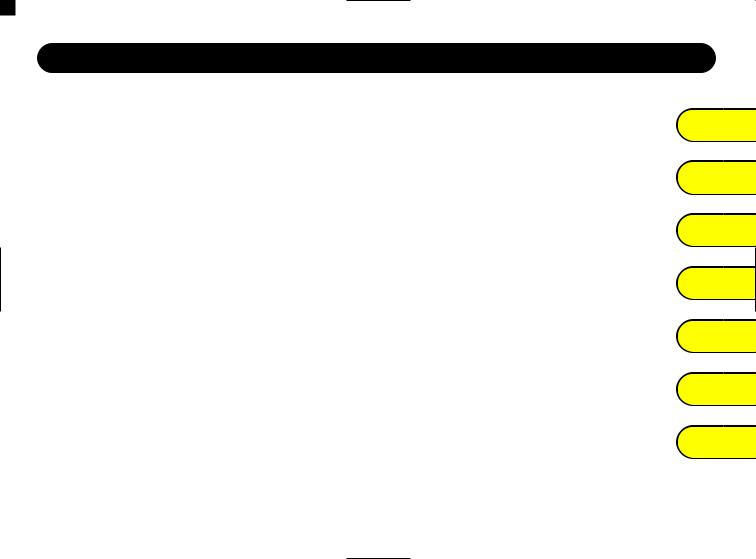
C |
O |
N |
T |
E |
N |
T |
S |
|
|
|
|
|
|
|
Sections |
Getting to know your vehicle |
............................................................ |
|
|
1 |
|||
Driving |
............................................................................................................... |
|
|
|
|
|
2 |
Your comfort ................................................................................................. |
|
|
|
|
|
3 |
|
Maintenance .................................................................................................. |
|
|
|
|
|
4 |
|
Practical advice |
........................................................................................... |
|
|
|
|
5 |
|
Technical specifications |
........................................................................ |
|
|
|
6 |
||
Alphabetical index .................................................................................... |
|
|
|
|
7 |
||
0.03

TYRE PRESSURES
(in bar or kg/cm2, when cold)
Tyre sizes |
195/65 R 16 |
215/65 R 16 |
225/65 R 16 |
205/75 R 16 |
||
(original fittings) |
||||||
|
|
|
|
|
||
|
|
|
|
|
|
|
Wheel sizes |
|
|
6 J 16 |
|
||
|
|
|
|
|
||
Front |
3.8 |
3.9 |
|
3.8 |
4.2 |
|
Rear |
3.8 |
4.3 |
|
4.4 |
4.75 |
|
Spare wheel |
3.8 |
4.3 |
|
4.4 |
4.75 |
|
|
|
|
|
|
|
|
Special features of 205/75 R 16 tyres
These tyres cannot be fitted with chains. Contact your RENAULT Dealer.
0.04
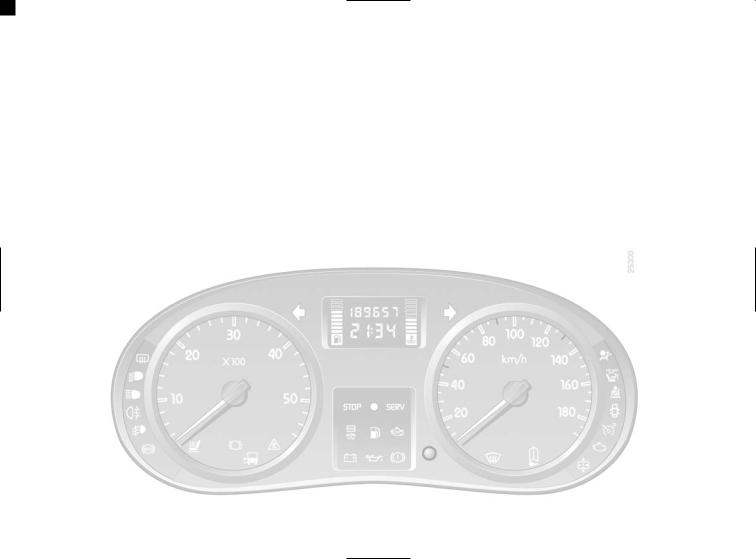
Section 1: Getting to know your vehicle
Keys - Remote control units ................................................................................................................ |
1.02 - 1.05 |
Doors .................................................................................................................................................... |
1.05 1.10 |
Dropside with side panels ................................................................................................................... |
1.11 - 1.12 |
Anti-intrusion alarm ............................................................................................................................. |
1.13 - 1.14 |
Engine immobiliser ......................................................................................................................................... |
1.15 |
Seats .................................................................................................................................................................. |
1.16 |
Headrests .......................................................................................................................................................... |
1.17 |
Seat belts ............................................................................................................................................... |
1.18 1.35 |
Front seat belt pretensioners .......................................................................................................................... |
1.20 |
Airbag .................................................................................................................................................. |
1.20 1.24 |
Child safety ........................................................................................................................................... |
1.27 1.35 |
Driver’s position .................................................................................................................................. |
1.36 1.39 |
Instrument panel ................................................................................................................................. |
1.40 1.50 |
Clock ................................................................................................................................................................. |
1.51 |
Exterior temperature ....................................................................................................................................... |
1.51 |
Rear-view mirrors ............................................................................................................................................ |
1.52 |
Windscreen wipers ........................................................................................................................................... |
1.53 |
Buzzers / Lights .................................................................................................................................. |
1.54 1.57 |
Electrical headlight beam adjustment ........................................................................................................... |
1.56 |
Fuel tank ............................................................................................................................................... |
1.58 - 1.59 |
1.01
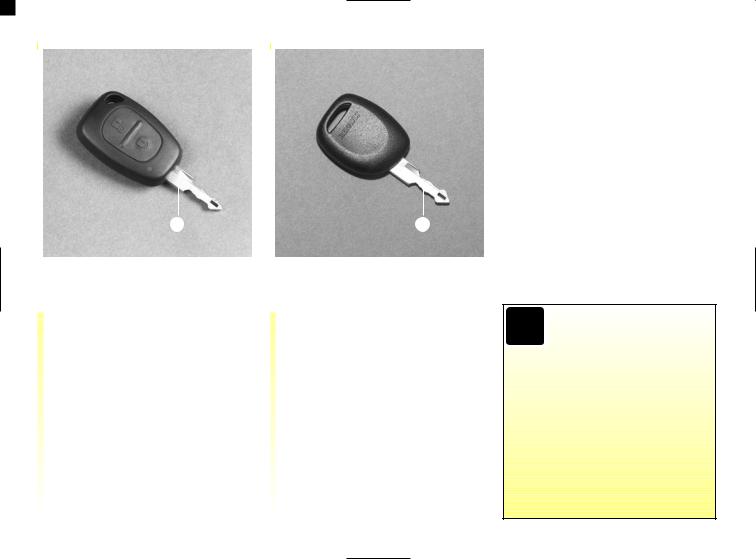
KEYS/REMOTE CONTROL UNITS
|
|
|
|
|
|
|
|
|
|
|
|
|
|
|
|
|
|
|
|
|
|
|
|
|
|
|
|
|
|
|
|
|
|
|
|
|
|
|
|
|
|
|
|
|
|
|
|
|
|
|
|
|
|
|
|
|
|
|
|
|
|
|
|
|
|
|
|
|
|
|
|
|
|
|
|
|
|
|
|
|
|
|
|
|
|
|
|
|
|
|
|
|
|
|
|
|
|
|
|
|
|
|
|
|
|
|
|
|
|
|
|
|
|
|
|
|
|
|
|
|
|
|
|
|
|
|
|
|
|
|
|
|
|
|
|
|
|
|
|
|
|
|
|
|
|
|
|
|
|
|
|
|
|
|
|
|
|
|
|
|
|
|
|
|
|
|
|
|
|
|
|
|
|
|
|
|
|
|
|
|
|
|
|
|
|
|
|
|
|
|
|
|
|
|
|
|
|
|
|
|
|
|
|
|
|
|
|
|
|
|
|
|
|
|
|
|
|
|
|
|
|
|
|
|
|
|
|
|
|
|
|
|
|
|
|
|
|
|
|
|
|
|
|
|
|
|
|
|
|
|
|
|
|
|
|
|
|
|
|
|
|
|
|
|
|
|
|
|
|
|
|
|
|
|
|
|
|
|
|
|
|
|
|
|
|
|
|
|
|
|
|
|
|
|
|
|
|
|
|
|
|
|
|
|
|
|
|
|
|
|
|
|
|
|
|
|
|
|
|
|
|
|
|
|
|
|
|
|
|
|
|
|
|
|
|
|
|
|
|
|
|
|
1 |
|
|
|
|
2 |
|
||
|
1 Radio frequency remote controls, |
|
2 Ignition key, key for doors and |
|||||||
|
|
|||||||||
|
|
|||||||||
|
|
|||||||||
|
ignition key, key for doors and |
|
fuel filler cap. |
|||||||
|
fuel filler cap. |
|
|
|
|
|
||||
|
|
|
|
|
|
|||||
|
|
|
|
|
|
|
|
|
|
|
|
|
|
|
|
|
|
|
|
|
|
If there is a child (or a pet)
in the vehicle, never leave
it unattended with the key
in the ignition. With the
key in the ignition he or she could
start the engine or operate
electrical equipment such as the
electric windows and there is a risk
that the child may be injured (by
trapping his or her neck, arm,
hand, etc.). Risk of serious injury.
1.02
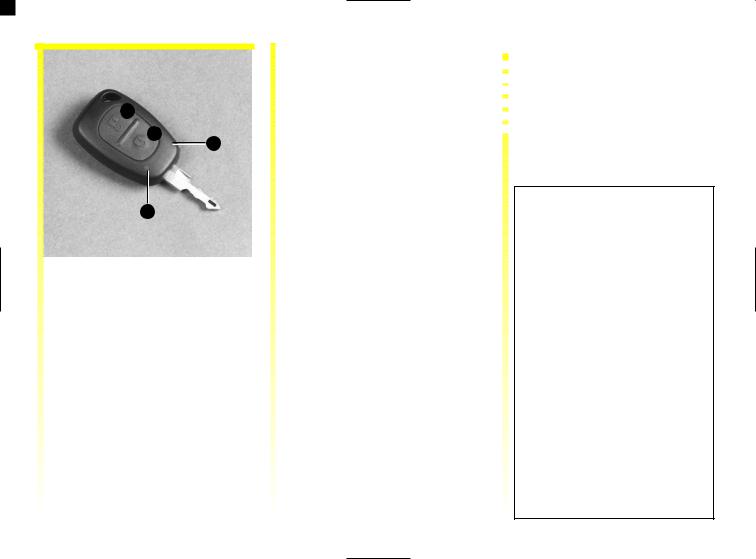
RADIO FREQUENCY REMOTE CONTROL
A
B
1
2
The remote control 1 locks and unlocks the doors.
It is supplied by a battery which must be replaced when battery warning light 2 no longer lights up. (Refer to the information on Locking remote control unit: batteries).
Locking/unlocking the doors
Press the remote control unit for approximately one second (indicator light 2 lights up) to lock (side B) or to unlock (side A).
Locking is indicated by two flashes of the hazard warning lights.
Note: depending on the vehicle, if either a door or the boot lid is open or not properly closed, the hazard warning lights will not flash.
Unlocking is indicated by the hazard warning lights flashing once.
Remote control unit operating range
This varies according to the surroundings: therefore when handling the remote control, be careful that you do not inadvertently lock or unlock the doors!
Note: on certain vehicles, if a door is not opened within approximately 30 seconds of the door being unlocked by remote control, the doors will lock again automatically.
 Interference
Interference
 Operation of the remote control may
Operation of the remote control may
 be disrupted by equipment being
be disrupted by equipment being
 used close to the vehicle (e.g.
used close to the vehicle (e.g.
 external equipment or the use of
external equipment or the use of
 devices which operate on the same
devices which operate on the same
 frequency as the remote control).
frequency as the remote control).
If you lose your keys or need another set of keys (or a remote control), contact your RENAULT Dealer.
• If a remote control is replaced, it will be necessary to take the vehicle and all sets of keys to your RENAULT Dealer to initialise the system.
• It is not possible to use more than two remote control units for one vehicle.
Make sure that the batteries are always in good condition - they last for approximately two years.
Refer to the Electric remote control door locking: batteries section of the driver's handbook for the procedure for changing the batteries.
1.03
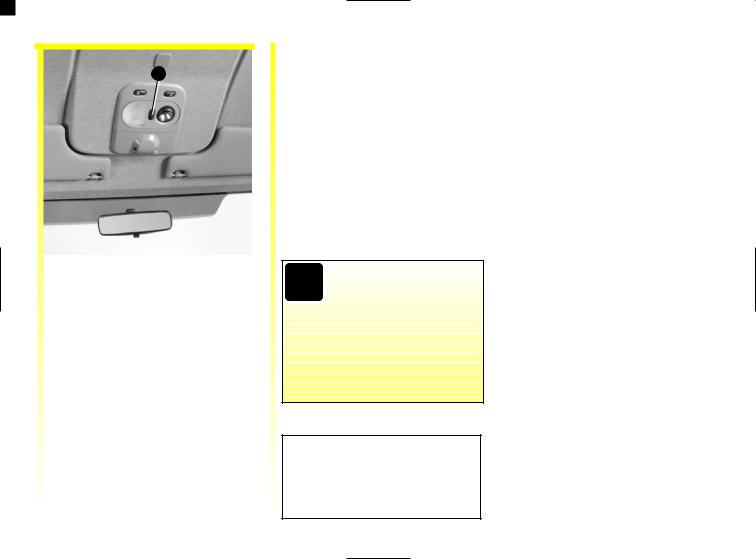
INTERIOR ELECTRIC DOOR LOCKING CONTROL
Note: central locking is neutralised
when a door is opened.
1
From inside with the electric central locking 1
This enables the all the doors to be locked simultaneously.
To lock, press the switch on the opposite side to that in the diagram.
If you decide to keep the
doors locked when you
are driving, remember
that it may be more
difficult for those assisting you
to gain access to your vehicle in
the event of an emergency.
NOTE
The front doors cannot be locked if the door is open.
1.04
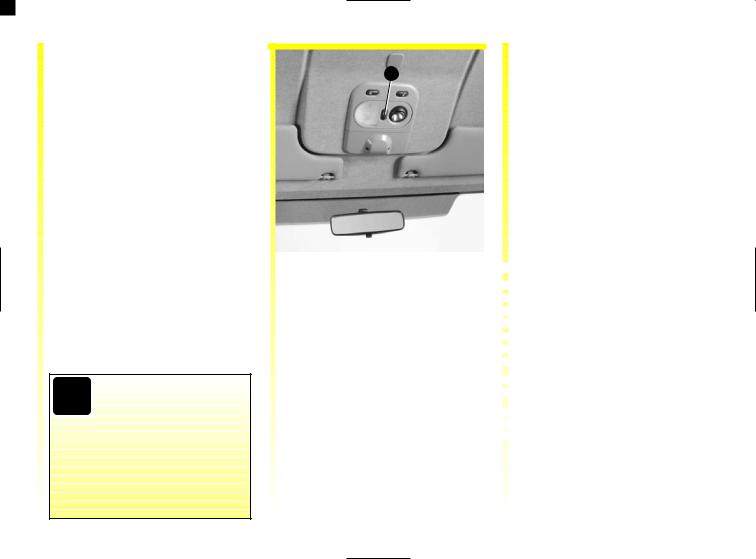
RAID (RENAULT ANTI-INTRUDER DEVICE)
You must first decide if you want to activate this function.
To activate
With the ignition on, press central door locking button 1 on the locking side (opposite the symbol) and hold for approx. 5 seconds, until you hear the operating noise (unlocking/ locking).
To deactivate it
With the ignition on, press central door locking button 1 on the unlocking side (symbol side) and hold for approximately 5 seconds, until you hear the operating noise (locking/unlocking).
If you decide to keep the
doors locked when you
are driving, remember
that it may be more
difficult for those assisting you
to gain access to your vehicle in
the event of an emergency.
1 |
Operating principle
When the vehicle moves off, the system automatically locks the doors and boot as soon as a speed of 4 mph (6 km/h) is reached.
The door is unlocked
-by opening a front door.
Note: If a rear door is opened, it will automatically be relocked when the vehicle reaches a speed of approximately 4 mph (6 km/h).
-by pressing the door unlocking button 1.
 Operating faults
Operating faults
 If you note that the system is not
If you note that the system is not
 operating correctly (automatic
operating correctly (automatic
 locking does not take place), first
locking does not take place), first
 check that all the doors have been
check that all the doors have been
 properly closed. If they are closed
properly closed. If they are closed
 correctly, contact your RENAULT
correctly, contact your RENAULT
 Dealer.
Dealer.
 Also make sure that locking has not
Also make sure that locking has not
 been deactivated inadvertently.
been deactivated inadvertently.
 If this is the case, switch the ignition
If this is the case, switch the ignition
 off and on again and reactivate the
off and on again and reactivate the
 system as described above.
system as described above.
1.05
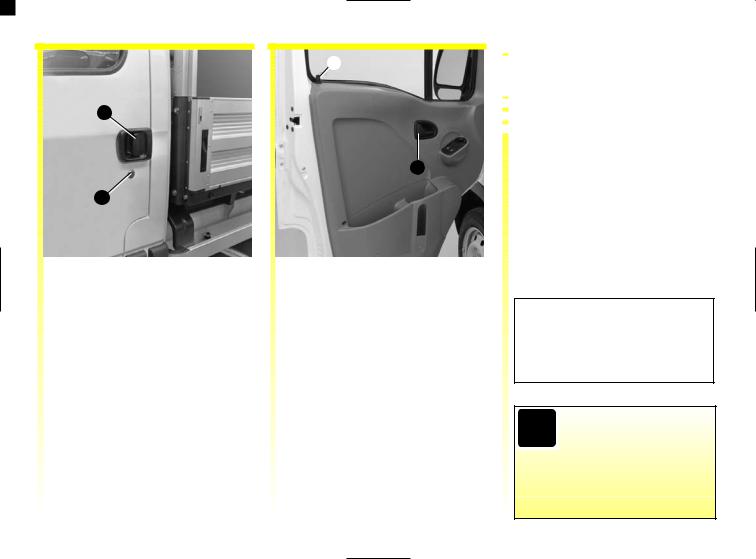
FRONT DOORS
1
2
Opening the doors from the outside
Unlock one of the front doors 2 or, depending on the vehicle, the driver's door lock.
Use the remote control if the function is available on the vehicle. Pull lever 1 towards you and open the door.
Closing from the outside
Push the door until it catches automatically. Lock it via lock 2 or use the remote control.
 Warning buzzer
Warning buzzer
3 |
|
|
When |
one |
of the front |
doors |
is |
|
|
||||||
|
|
|
opened, a |
warning buzzer will |
|||
|
|
|
|||||
|
|
|
sound |
to |
indicate |
that |
the |
|
|
|
|||||
 headlights are still on when the
headlights are still on when the
 engine has been switched off (to
engine has been switched off (to
 prevent discharge of the battery).
prevent discharge of the battery).
4
Opening the doors from the inside
Pull handle 4 and push open the door.
Closing from the inside
Pull the door until it catches automatically.
Manual locking
With the door closed, lock the door by pressing button 3.
NOTE
The front doors cannot be locked if the door is open.
As a safety precaution,
the doors should only be
opened or closed when
the vehicle is stationary.
1.06
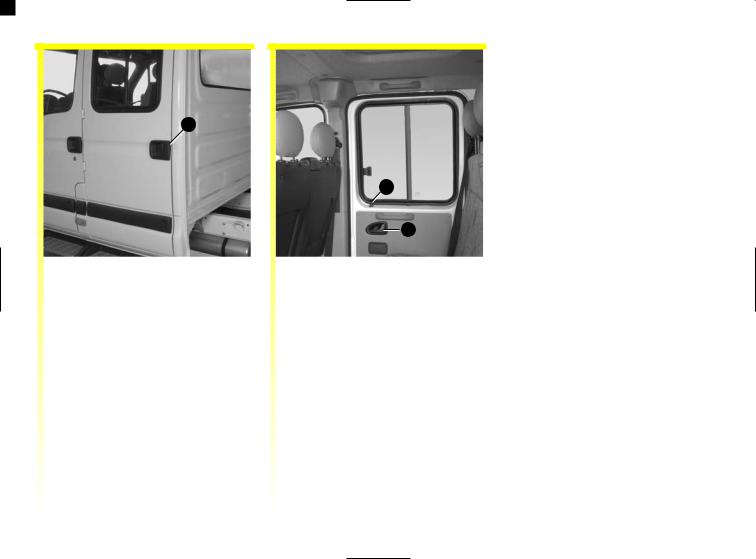
SIDE HINGED DOORS
1
Opening the doors from the outside
Pull handle 1 towards you after unlocking the door from the inside.
Closing from the outside
Push the door until it catches automatically.
2
3
Opening from the inside
Pull handle 3 and push the door.
Closing from the inside
Pull the door until it catches automatically.
Manual locking
With the door closed, lock the door by pressing button 2.
1.07
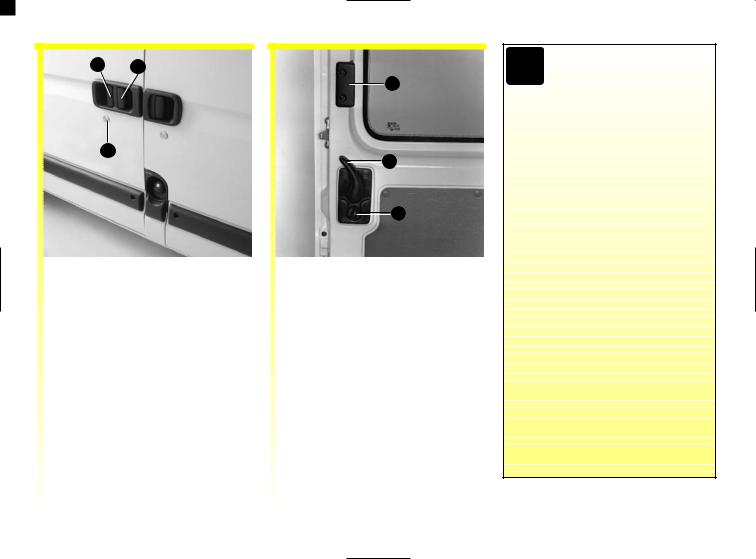
SLIDING SIDE OPENING DOORS
2 3
4
1
5
6
Opening the doors from the outside
Unlock front door lock 1 with a key, or, for vehicles equipped with remote control, use the remote control unit. Pull lever 3 towards you and slide the door towards the rear.
Closing from the outside
Slide the door towards the front of the vehicle holding fixed door handle 2 until the door is fully closed.
Lock it with key 1 or use the remote control.
Opening the doors from the inside
Pull handle 5 towards the rear and open the sliding door to the point where it locks into position.
Closing from the inside
Holding handle 4, slide the door until it catches automatically.
Manual locking
Use button 6.
Recommendations concer-
ning the sliding side door.
Appropriate precautions
must be taken when
opening or closing the sliding door,
as is the case for any of the doors or
the boot on the vehicle:
•Check that the door will not come into contact with a person's arm or hand, an animal's paw or an object.
•Use only the handles on the inside and outside of the door to operate it.
•Take care when opening and closing the door.
•Take particular care when the vehicle is parked on a slope: open the door with care until it is fully open and latches into its locking position.
•Before moving off, always ensure that the sliding door is properly closed.
1.08
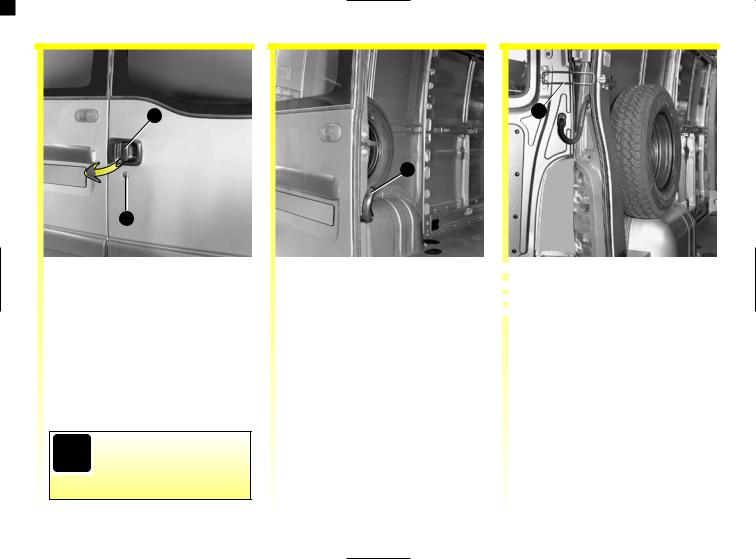
REAR DOORS
1 |
4 |
|
3
2
Opening the doors from the outside
Unlock 2 with the door key, or for vehicles equipped with one, use the remote control. Pull handle 1 towards you and open the right-hand door.
There is no device to
restrain the doors in the
wind.
Pull handle 3 and open the left-hand door.
 Opening the doors to 180°
Opening the doors to 180°
 Remove check-strap 4 from its
Remove check-strap 4 from its
 housing. Open the door as far as
housing. Open the door as far as
 possible.
possible.
1.09
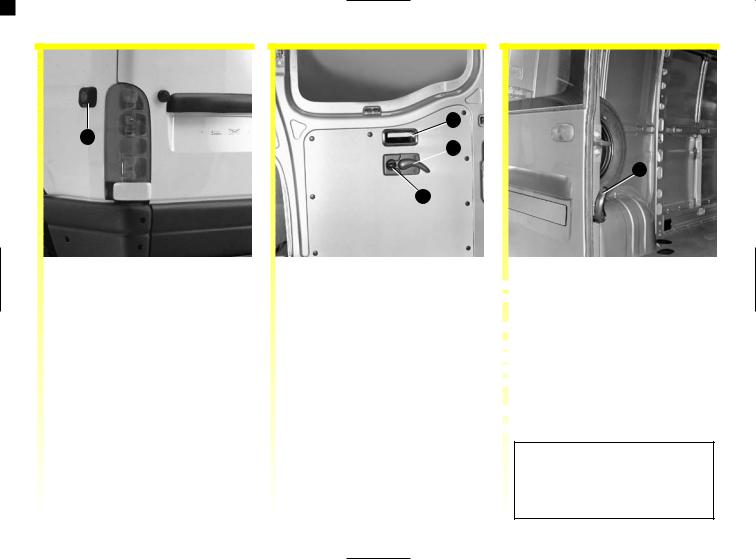
REAR DOORS (continued)
6
5
 7
7
9
8
Opening the doors to 270°
Release the tie-rod from its housing as for opening to 180°. Open the door fully to its stops on magnets 5 located on the side panels.
Closing from the outside
Return the doors to almost-closed position and slam them shut.
Lock with the key.
Opening the doors from the inside
Lift handle 7 and push the right-hand door.
 Pull down handle 9 and open the
Pull down handle 9 and open the
 left-hand door.
left-hand door.
 Closing from the inside
Closing from the inside
 Starting with the left-hand door,
Starting with the left-hand door,
 return the doors to an almost-closed
return the doors to an almost-closed
 position and then slam them shut.
position and then slam them shut.
 Use handle 6.
Use handle 6.
 Locking, unlocking
Locking, unlocking
 Use button 8.
Use button 8.
Start by closing the left-hand door and then close the right-hand door.
1.10
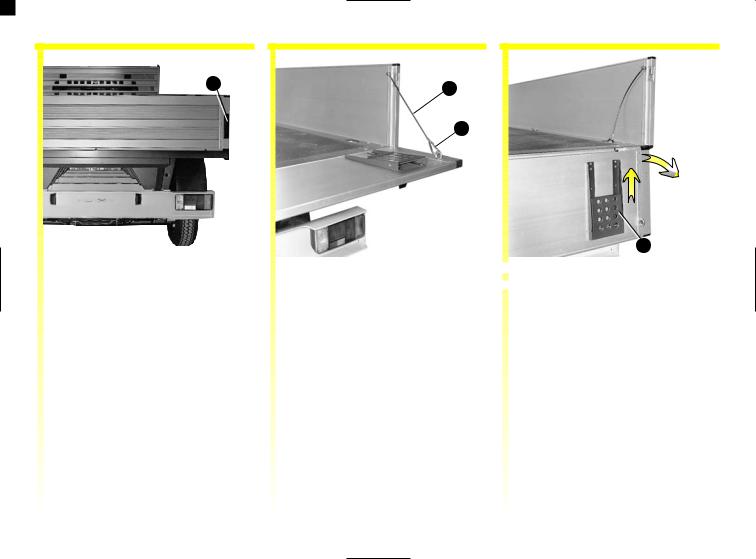
DROPSIDE WITH SIDE PANELS
1 |
A
Opening the rear panel A
Check that the retaining cables 2 are properly attached.
Lower the levers 1 completely. Lower the rear panel.
Folding the rear panel A
Release hooks 3 and lower the rear panel completely.
2
3
A
Removing the rear side panel from its hinges A
This operation can only be carried out after removing the left-hand side panel from its hinges (refer to the following page).
With the side panel in horizontal position, release hooks 3 and slide the side panel towards the left.
Closing the rear panel A
Proceed in the reverse order to opening. Check that the levers are properly locked 1.
4
 Foot panel 4
Foot panel 4
 Gently raise and lower the plate.
Gently raise and lower the plate.
1.11
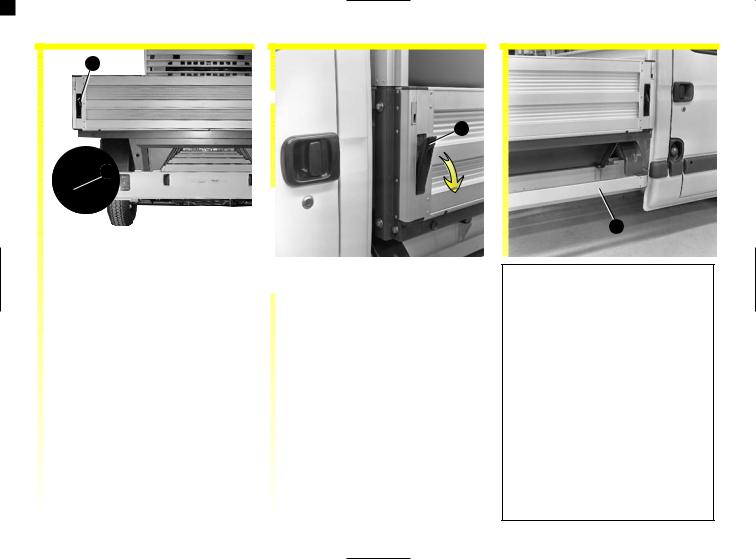
DROPSIDE WITH SIDE PANELS (continued)
5 |
A  B
B
7
 6
6
Opening a side panel B |
|
Removing a side panel from its |
|
||
|
||
|
||
|
||
|
||
|
||
|
||
|
||
|
||
|
||
• The rear panel A is closed |
|
hinges B |
|
||
|
Lower lever 5 completely. It is essential to unfasten hook 6.
Lower lever 7 and side panel B completely.
With the side panel on its side, release hook 6 and slide the side panel towards the rear.
•The rear panel A is suspended
Lower lever 7 completely and lower side panel B.
Closing a side panel B
Proceed in the reverse order to opening. Check that levers 5 and 7 are correctly locked.
Special note
The panels are designed so that a tonneau cover with tensioning devices can be attached.
8
The lower bars 8 cannot support a person's weight.
Whenever loading, take care to follow local laws regarding the transport of objects, e.g.:
-draw attention to any object which exceeds the length of the bed;
-check that the vehicle's exterior lights and number plate are still visible;
-secure transported objects using the lashing rings on the loading bed, etc.
1.12

ANTI-INTRUSION ALARM
It protects the vehicle by performing the following functions:
- volumetric protection of the front passenger compartment using an ultrasound field;
- protection of the passenger compartment perimeter;
- protection of the rear cell perimeter and bonnet;
- surveillance in the event of an attempt to start the engine with an incorrect ignition key;
- surveillance in the event of horn power supply cut-off.
Before activating the alarm function
Check that:
-the windows and doors are properly closed;
-there are no passengers, animals or objects inside the vehicle which could move and set off the alarm. Otherwise, it will be necessary to disable promptly the spatial protection, refer to the section on disabling the spatial protection.
1
 Spatial protection is disabled (in
Spatial protection is disabled (in
 the event, for example, of there
the event, for example, of there
 being a moving object or animal in
being a moving object or animal in
 the vehicle).
the vehicle).
 Press the locking side 1 of the
Press the locking side 1 of the
 remote control locking unit, the
remote control locking unit, the
 horn will bleep to confirm
horn will bleep to confirm
 disablement.
disablement.
 It remains disabled even if you
It remains disabled even if you
 press the locking side 1 of the
press the locking side 1 of the
 remote control locking unit several
remote control locking unit several
 times.
times.
 Disablement is cancelled each time
Disablement is cancelled each time
 the doors are unlocked.
the doors are unlocked.
1.13
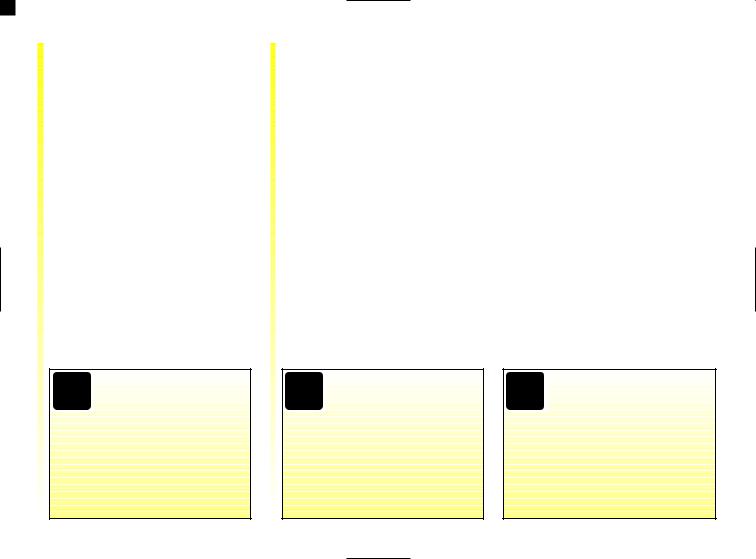
ANTI-INTRUSION ALARM (continued)
Activating the alarm function |
Deactivating the alarm function |
The alarm is set when the doors are locked with the remote control unit.
This is signalled by the hazard warning lights flashing twice
When the alarm function is activated, any detection leads to the alarm being triggered and the hazard warning lights flashing for around 25 seconds.
After approximately 5 seconds, if the detection continues, the system will start once more for approximately 25 seconds and then again (8 to 10 times, depending on the type of detection).
Beyond that, there is no more surveillance until the doors are next unlocked/locked.
The alarm, even when triggered, stops:
-when the doors are unlocked with the remote control unit;
-when the vehicle ignition is switched on.
Deactivation is indicated by the hazard warning lights flashing once.
The absence of flashing
hazard warning lights
when the alarm is set
indicates that a door or
the bonnet is open or incorrectly
closed: check. If this is not the
case, contact your RENAULT
Dealer.
Failure of the hazard
warning lights to flash
when the alarm is
deactivated indicates that
the alarm was triggered during
your absence.
Opening the doors with the
key does not stop the alarm;
it must be stopped using
the remote control unit or
by switching on the ignition.
1.14
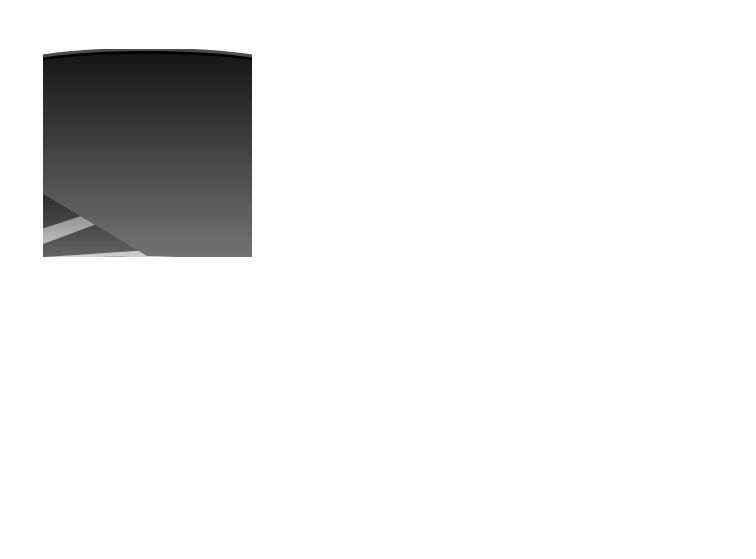
ENGINE IMMOBILISER
1
Immobiliser warning light
This prevents the vehicle
being driven by anyone not in possession of the vehicle's coded ignition key.
|
Any work on or modi- |
||
|
fication |
to |
the engine |
|
immobiliser |
system |
|
|
(computers, wiring, etc.) |
||
may be dangerous. Work must be |
|||
carried |
out |
by |
qualified |
RENAULT personnel. |
|||
Operating principle
The vehicle is automatically protected a few seconds after the key is removed from the ignition.
If the vehicle does not recognise the ignition key code, warning light 1 will flash continuously and the engine cannot be started.
•Engine immobiliser operation indicator light
When the ignition is switched on, indicator light 1 lights up continuously for approximately three seconds and then goes out. The vehicle has recognised the code. You can then start the engine.
•Vehicle protection indicator light
A few seconds after the ignition has been switched off, indicator light 1 will flash continuously.
The vehicle will not be protected until the key has been taken out of the ignition.
 • Operating fault warning light
• Operating fault warning light
After the ignition has been
switched on, if warning light 1
remains continuously lit or
continues to flash, this indicates an operating fault in the system.
In all cases, it is essential to contact a RENAULT Dealer. Only RENAULT Dealers are qualified to repair the engine immobiliser.
 If the coded ignition key is faulty,
If the coded ignition key is faulty,
 use the second key (supplied with
use the second key (supplied with
 the vehicle). If you do not have
the vehicle). If you do not have
 access to this, it is essential to
access to this, it is essential to
 contact a RENAULT Dealer. Only
contact a RENAULT Dealer. Only
 RENAULT Dealers are authorised to
RENAULT Dealers are authorised to
 repair the engine immobiliser
repair the engine immobiliser
 system.
system.
1.15
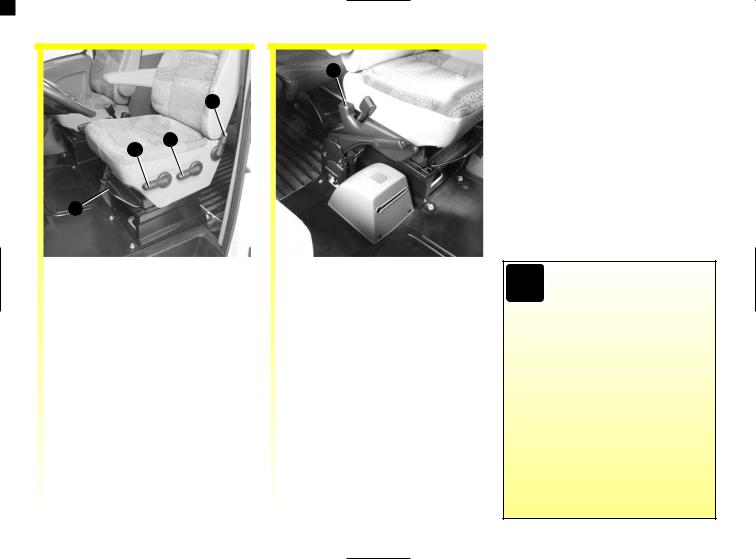
SEATS
5
4
3
2
1
Front seat adjustment
To move forwards or backwards
Lift bar 1 to release. Release the bar once the seat is in the correct position and ensure that the seat is fully locked into position.
To tilt the seatback
Use lever 4.
To adjust the height of the seat base
Adjustment is made in two stages: For the front section of the seat, lift lever 2.
For the rear section of the seat, lift lever 3.
Heated seats
Press switch 5 , an operating
light will light up on the instrument panel.
We would advise you not to
recline the seatbacks too far
to ensure that the
effectiveness of the seat
belts is not reduced.
Make sure the seatback is locked in
place correctly.
Nothing should be placed on the
floor (area in front of driver) as
such objects may slide under the
pedal during sudden braking
manoeuvres and obstruct its use.
1.16
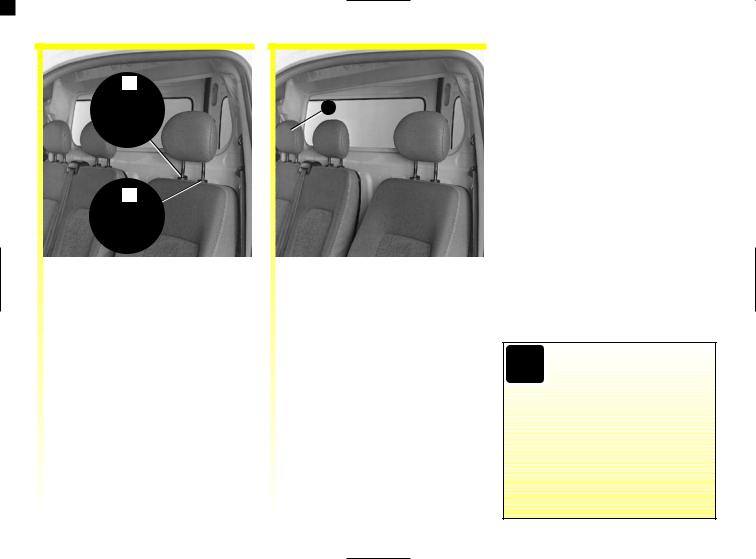
HEADREST
A
B
Adjustment
To fit it
Simply slide it up.
To lower it
Press tab A and lower it at the same time.
To remove the headrest
Raise the headrest and then press tabs A and B to release it.
1
D
C
To fit the headrest
Fit the rods into the sleeves, with the notches towards the front, and push the headrest down until the desired height is reached, pressing tab A at the same time.
Special case
If the vehicle is fitted with a bench seat on the passenger side C and a partition D, it is not possible to remove side headrest 1.
As the headrest is a safety |
|||
component, |
check |
its |
|
presence |
and |
correct |
|
positioning: |
the |
distance |
|
between your head and the |
|||
headrest should be minimal, the |
|||
top of the headrest should be as |
|||
close as possible to the top of your |
|||
head. |
|
|
|
|
|
|
1.17 |
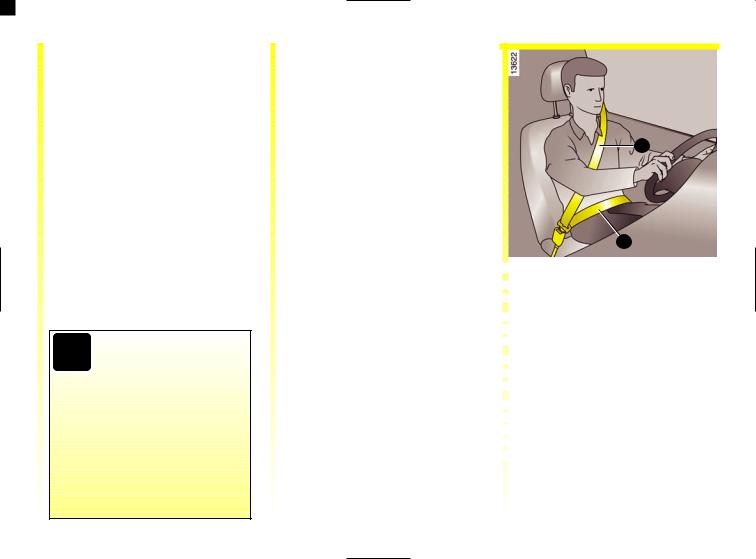
FRONT SEAT BELTS
Always wear your seat belt when travelling in your vehicle. You must also comply with the local legislation of the particular country you are in.
Before driving off:
- First ensure that your driving position is correct.
- then adjust your seat belt to obtain the best possible protection.
Incorrectly adjusted seat
belts may cause injuries
in the event of an
accident.
Even pregnant women should
wear a seat belt. In this case,
ensure that the lap belt is not
exerting too much pressure on
the abdomen but do not allow
any slack.
Adjusting your driving position
•Sit well back in your seat (having removed your coat or jacket).
This is essential to ensure your back is positioned correctly.
•Adjust the distance between the seat and the pedals.
Your seat should be as far back as possible while still allowing you to be able to fully depress the clutch pedal. The seatback should be adjusted so that your arms are slightly bent when you hold the steering wheel.
•Adjust the position of your headrest.
For maximum safety, the top of your head should be in line with the top of the headrest.
•Adjust the height of the seat base.
This adjustment allows you to select the seat position which offers you the best possible vision.
1
2
 Adjusting the seat belts
Adjusting the seat belts
 Sit with your back firmly against the
Sit with your back firmly against the
 seatback.
seatback.
 Shoulder strap 1 should be as close
Shoulder strap 1 should be as close
 to the base of your neck as possible
to the base of your neck as possible
 but not on it.
but not on it.
 The lap strap 2 should be worn flat
The lap strap 2 should be worn flat
 over your thighs and against your
over your thighs and against your
 pelvis.
pelvis.
 The belt should be worn so that it is
The belt should be worn so that it is
 as close to your body as possible.
as close to your body as possible.
 Avoid wearing heavy clothing or
Avoid wearing heavy clothing or
 keeping bulky objects under the
keeping bulky objects under the
 belts.
belts.
1.18
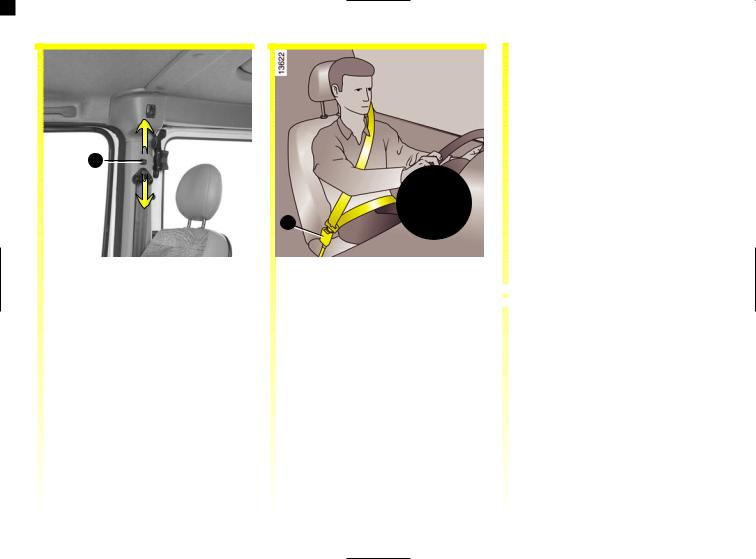
FRONT SEAT BELTS (continued)
3
4 5
6
6
Adjusting the height of the seat belt
Press button 3 to select the position you require so that shoulder strap 1 is worn as described above.
Make sure that the seat belt is locked in position correctly after you have adjusted it.
To fasten
Unwind the belt slowly and smoothly and ensure that tongue 4 locks into buckle 6 (check that it is locked by pulling on tongue 4). If the belt jams, allow it to run back before attempting to unwind it again.
To fasten (continued) |
If your belt becomes completely |
jammed: |
- pull the belt slowly but firmly so |
that just over an inch (3 cm) |
unwinds; |
- then allow the belt to rewind |
automatically; |
- unwind it again; |
- if the fault is still present, contact |
your RENAULT Dealer. |
Unlocking |
Press button 5 on buckle 6 and the |
seat belt will be rewound by the |
inertia reel. |
 Guide the buckle to help the
Guide the buckle to help the
 operation.
operation.
1.19
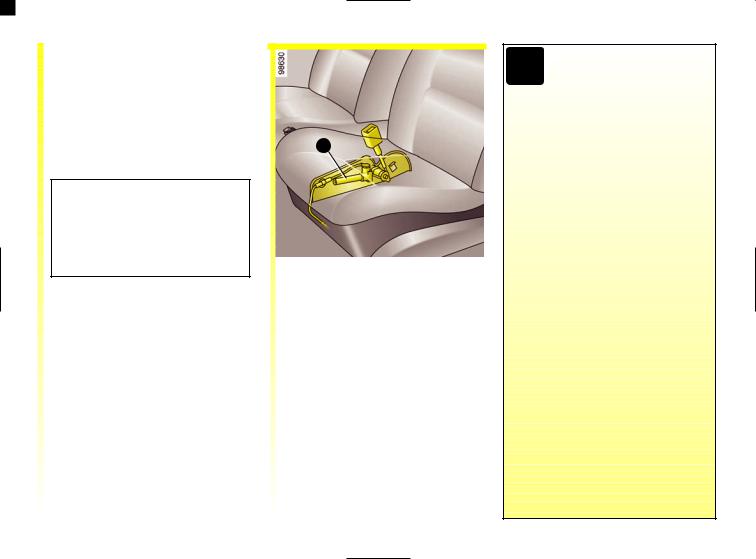
METHODS OF RESTRAINT IN ADDITION TO THE FRONT SEAT BELTS
Depending on the version, these include:
■Seat belt pretensioners (described below).
■Driver and front passenger airbags
(described on the following pages).
The passenger airbag protects the front passenger(s) (depending on whether there is a conventional seat or a bench seat in the front).
These systems are provided to act independently or together when the vehicle is subjected to frontal impacts.
There are three possibilities, depending on the force of the impact:
-protection is provided by the belt only;
-the pretensioner is triggered to rectify belt position and take up play in the belt;
-the airbag will inflate in the most severe cases.
1 |
Front seat belt pretensioners
This system is only operational when the ignition is switched on.
If the vehicle is subject to a severe frontal impact, piston 1 immediately retracts the seat belt buckle pulling the seat belt tight against the body and thereby improving its efficiency.
• After an accident, have
the entire restraint
system checked
•No operation whatsoever is permitted on any part of the system (pretensioners, airbags, computers, wiring) and the system components must not be reused on any other vehicle, even if identical.
•To avoid premature triggering of the system which may cause injury, only qualified RENAULT Network personnel may work on the pretensioner and airbag system.
•Testing of the electric trigger system may only be carried out by a specially trained technician using special equipment.
•When the vehicle is scrapped, contact your RENAULT Dealer for disposal of the pretensioner and airbag gas generators.
1.20
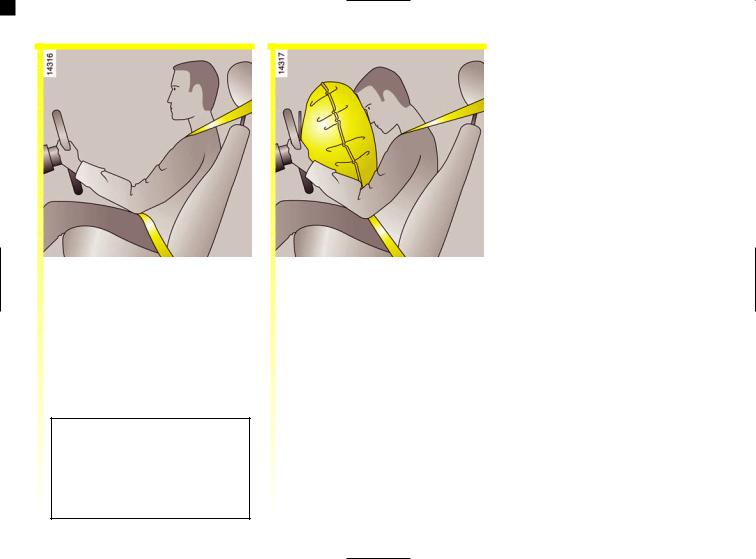
METHODS OF RESTRAINT IN ADDITION TO THE FRONT SEAT BELTS (continued)
Driver and passenger airbags
An airbag may be provided for both the driver and the front passenger.
Airbag inscriptions on the steering wheel and dashboard together with a label on the lower part of the windscreen indicate that the vehicle is equipped with airbags.
The passenger airbag protects the front passenger(s) (according to whether there is a conventional seat or a bench seat in the front).
Each airbag system consists of:
-an airbag and gas generator fitted on the steering wheel for the driver and in the dashboard for the front passenger;
-a computer for both systems, which includes the impact sensor and a monitor controlling the electrical trigger system for the gas generator;
- A single warning light |
on |
the instrument panel. |
|
1.21
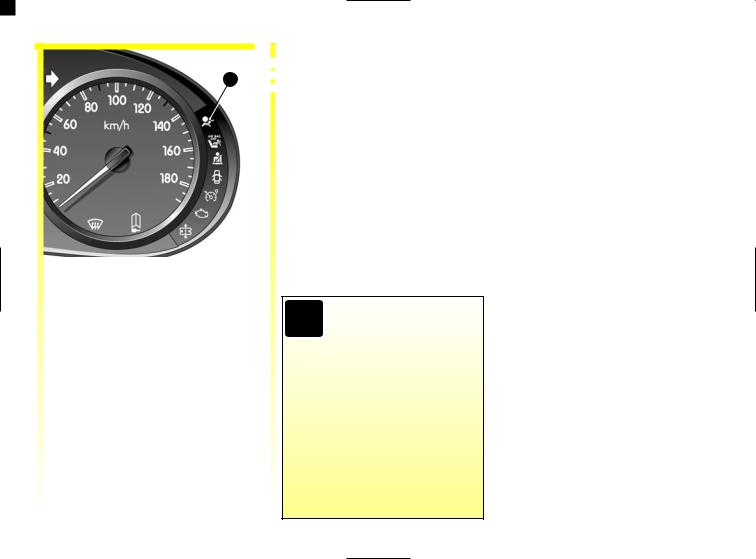
METHODS OF RESTRAINT IN ADDITION TO THE FRONT SEAT BELTS (continued)
Operating faults
 Warning light 1 lights up on the 1
Warning light 1 lights up on the 1  instrument panel when the ignition
instrument panel when the ignition  is turned on and then goes out after
is turned on and then goes out after
a few seconds.
If it does not light up when the
ignition is switched on, or comes on
when the engine is running, there is
a fault in the system.
Consult your RENAULT Dealer as soon as possible. Your protection will be reduced until this fault is rectified.
Driver and passenger airbags
(continued) Operation
The system is only operational when the ignition is switched on (ignition key in M position).
If a severe frontal impact occurs, the airbag(s) inflate(s) rapidly, cushioning the impact of the driver's head and chest against the steering wheel and the front passenger's head against the dashboard. The airbag then deflates immediately so that the passengers are not impeded in any way when they get out of the vehicle.
The airbag system uses
the principles of pyro-
technics. Therefore, when
the airbag inflates, it will
generate noise, heat and smoke
upon detonation, this does not
mean that a fire is about to start.
In a situation where an airbag is
required, it will inflate
immediately and this may cause
some minor, superficial grazing
to the skin.
1.22
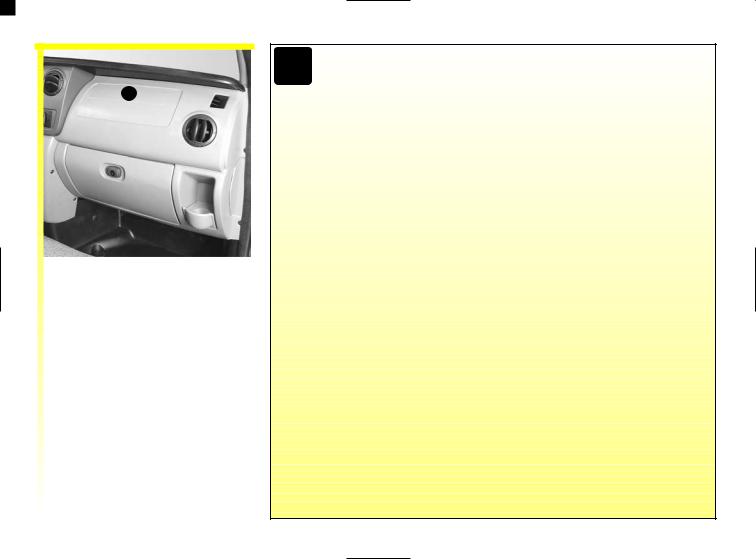
METHODS OF RESTRAINT IN ADDITION TO THE FRONT SEAT BELTS (continued)
A
All the warnings below are given so that, if the airbag is activated, it is not obstructed in any way and also to prevent the risk of serious injuries caused by items which may be dislodged when the airbag inflates.
Warnings concerning the driver’s airbag
• Do not adjust the steering wheel or the cushion.
•Do not cover the steering wheel cushion.
•Do not attach any objects (badge, logo, clock, telephone holder, etc.) to the steering wheel cushion.
•The steering wheel must not be removed (except by qualified personnel from the RENAULT network).
•Do not sit too close to the steering wheel. Sit with your arms slightly bent (see “Adjusting your driving position” in Section 1). This will allow sufficient space for the airbag to inflate properly and be fully effective.
Warnings for passenger airbag: location A
•Do not attach or glue any objects (pins, badges, clock, telephone holder, etc.) to the dashboard in the proximity of the airbag housing.
•Nothing should be placed between the dashboard and the passenger (pet, umbrella, walking stick, parcels, etc.).
•The passenger must not put his or her feet on the dashboard or seat as there is a risk that serious injuries may be sustained. As a general rule, keep all parts of the body (knees, hands, head, etc.) well away from the dashboard.
A REAR-FACING CHILD/BABY SEAT MUST NOT BE FITTED TO THE PASSENGER SEAT IF THE VEHICLE IS EQUIPPED
WITH A PASSENGER AIRBAG.
1.23
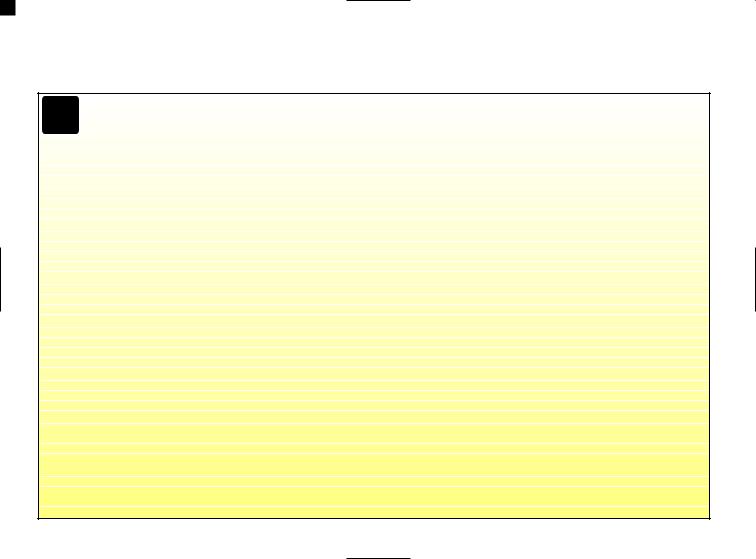
METHODS OF RESTRAINT IN ADDITION TO THE FRONT SEAT BELTS (continued)
All of the warnings below are given so that the airbag is not obstructed in any way when it is inflated and also to prevent the risk of serious injuries caused by items which may be dislodged when the airbag inflates.
The airbag is designed to complement the action of the seat belt. Both the airbags and seat belts are integral parts
of the same protection system. It is therefore essential to wear the seat belt at all times. If seat belts are not worn,
the occupants of the vehicle are exposed to a risk of serious injury in the event of an accident. The risk of minor
superficial injuries occurring when the airbag is deployed may also increase, although such minor injuries are
always possible with airbags.
If the vehicle should overturn, or in the event of a rear impact, however severe, the pretensioners and airbags are not
always triggered. These systems may, however, be triggered by shocks to the vehicle underbody, e.g. from kerbs,
potholes, stones, etc.
•It is strictly forbidden to work on or modify any part of the airbag system (electronic units, wiring, etc.). Such work must only be undertaken by qualified RENAULT Network personnel.
•To ensure that the system is in good working order and to avoid accidental triggering of the system which may cause injury, only qualified Renault Network personnel may work on the airbag system.
•As a safety precaution, have the airbag system checked if your vehicle has been involved in an accident, stolen or broken into.
•When selling or lending the vehicle, inform the user of these points and hand over this handbook with the vehicle.
•When scrapping your vehicle, contact your RENAULT Dealer for disposal of the gas generator(s).
1.24
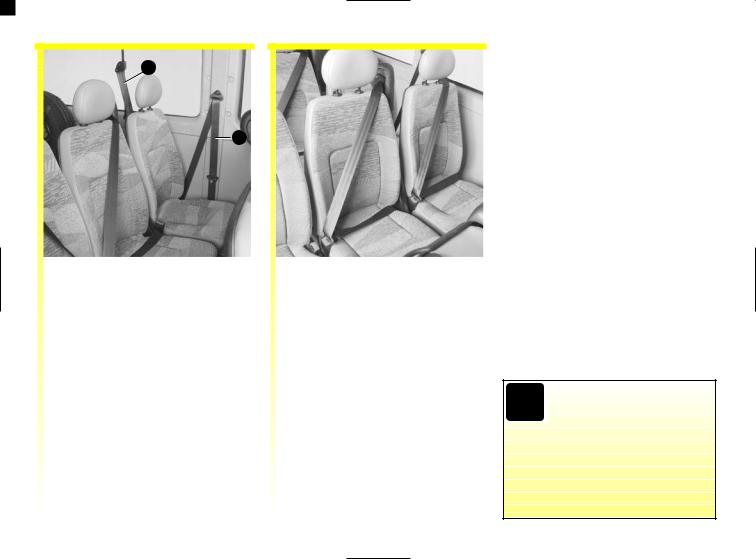
REAR SEAT BELTS
1
2
Rear side seat belts
(Vehicles fitted with rear bench seats)
The side seat belts are fitted with specific buckles so that it is not possible to lock the belt into the wrong housing: for the first housing use belt 2; for the second use belt 1.
Rear seat belts with inertia reel
The belts are fastened, unfastened and adjusted in the same way as the front belts.
Slowly unwind the belt.
Click the tongue into the buckle.
Make sure that the rear
bench seat is locked in
position correctly so that
the seat belts will operate
efficiently.
Refer to the information on the
rear seat in Section 3.
1.25
